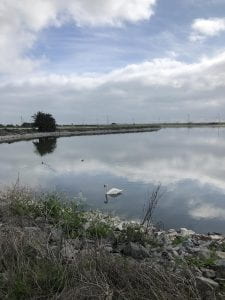Ebird List Link: https://ebird.org/checklist/S65463699
Date: 03/05/2020
Location: Las Gallinas Valley Sanitary District, Marin County, (38.027411, -122.515583) at an elevation of approximately -5 feet (-1.524 meters). Refer to the map below for where observations were recorded.
Site Description: The site would be classified as a valley, surrounded by mid to larger-sized mountains. Mount Diablo was located to the East, and Mount Tamalpais was located to the west. General topographical features of the site included a freshwater marsh, irrigated pastures, storage ponds, and a saltwater marsh. Most of our observations were done at the first and largest pond on the trail. This pond had three small islands with shoreline areas and areas of dense vegetation at their centers. The shores of the ponds were lined by a variety of grasses and rushes. The area overall had a very sparse amount of trees. The irrigated pastures located around the edge of the ponds provided a large open-aired environment. The most abundantly observed species were: Red-winged Blackbirds (300), Mallard Ducks (52), Tree Swallows (30), Cinnamon Teals (30), American Coots (19), Canadian Geese (18), Double-crested Cormorants (15), American Crows (12), Green-winged Teals (10), White-crowned Sparrows (10), Marsh Wrens (11), Snowy Egrets (9), Common Mergansers (7), Common Gallinules (7), Northern Harriers (6), Black-crowned Night-Herons (6), Northern Shovelers (6), Black Phoebes (5), and Short-billed Dowitchers (5). Other species observed were: Eurasian Collared-Doves (4), Wilson’s Snipes (4), American White Pelicans (4), European Starlings (4), Common House Finches (3), Gull species (3), Killdeers (3), Mute Swans (3), Blue-winged Teals (2), American Wigeons (2), Pied-billed Grebes (2), White-tailed Kites (2), Red-tailed Hawks (2), Golden-crowned Sparrows (2), Common Yellowthroats (2), a Song Sparrow (1), a Wrentit (1), a Common Raven (1), a Downy Woodpecker (1), a Turkey Vulture (1), a Great Egret (1), a Forster’s Tern (1), a Greater Yellowlegs (1), and a Bufflehead (1).
Species Account: A unique bird call was heard coming from inside the dense vegetation near the edge of one of the marsh areas. The call was very high pitched and was exhibited in bursts of threes. The call would best be described as a “wichety-wichety-wichety” noise. Based on its call, I assumed it would be some type of songbird. It took several minutes of waiting in silence before the bird moved to a higher-up area in the dense vegetation, making it more easily spottable. I thought that the bird was either really alert in our presence, or that remaining low in vegetation was a characteristic of its behavior (for example, when foraging). The first thing I noticed when locating the bird through my binoculars was the distinctive features of its plumage near the face. The throat of the bird was a brilliant bright yellow which highly contrasted with the black mask across its eyes. The bird was identified as a Common Yellowthroat. Common Yellowthroats (Geothlypis trichas) are of the order Passeriformes and family Parulidae. They are medium to small-size songbirds, more specifically warblers. To scale, their body size is slightly smaller than that of a Ruby-crowned Kinglet. Their body shape is round, with a rounded head and slightly rounded tail. Their beaks are small and pointed, which aids in insect foraging. The males have a bright yellow throat, black eye mask, and thin white line separating the upper part of the mask from the olive-brown color of the rest of the body. The females also have a yellow throat and olive-brown body color but lack the black eye mask. This type of bird inhabits open areas with thick, low vegetation. For example, the marsh in which we observed our Yellowthroat. As insect foragers, they spend a large amount of their time in the thick, low vegetation searching for food. Yellowthroats are short-distance migratory birds, moving to the southern United States for winter. During migratory periods, Yellowthroats may join other warblers in mixed flocks. The males are the ones that sing the “wichety-wichety-wichety” song we heard. However, both sexes make a “chuck” noise.


Sources:
- “Common Yellowthroat – EBird.” Ebird.Org, https://ebird.org/species/comyel/. Accessed 22 Mar. 2020.
- “Common Yellowthroat Overview, All About Birds, Cornell Lab of Ornithology.” Www.Allaboutbirds.Org, https://www.allaboutbirds.org/guide/Common_Yellowthroat/id. Accessed 22 Mar. 2020.
- “Common Yellowthroat – Audubon Guide to North American Birds.” Audobon.Org. https://www.audubon.org/field-guide/bird/common-yellowthroat. Accessed 22 Mar. 2020
Narrative: Observations occurred along a trail over 1.13 miles. The weather was cloudy with mild winds. The temperature was around 60 to 64 degrees Fahrenheit. Great diversity and abundance of species were observed across the area. Over the duration of the trip (207 minutes), forty-two species were observed. There were several behaviors I noted down for some of the species that I found interesting and potentially helpful for future identification. There were groups of different songbirds hiding in low vegetation near the edge of the water, they moved around very quickly and it was really difficult to identify them. However, I noticed that the Marsh Wrens all had their tails cocked upwards to the sky, which made distinguishing them from sparrows and other wrens easier. I also noticed that the Red-winged Blackbirds were gathered in large groups and were extremely vocal. Mixed in with the Red-winged Blackbirds were some European Starlings. I found it really interesting for two species to be mixing together and getting along. This contrasted with the interaction I observed between a Northern Harrier and American Crow. The Northern Harrier was flying in the open above an irrigated pasture, low to the ground and likely hunting. Swooping in from another direction, an American Crow mobbed the Northern Harrier. The crow appeared to annoy the Harrier enough that it flew away, leaving the area to the crow. It was really fascinating to me to be able to see two types of interactions between species in one environment, ranging from mutual acceptance of the presence of each other to purposely driving one another away.
Additional Photos or Media:





